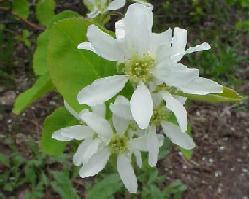
Photo by Thayne Tuason

Photo by Thayne Tuason
Western (Saskatoon)
Serviceberry
Amelanchier alnifolia Nutt.
Early flowering shrub, deciduous native usually grows 10-12 feet
tall 5
white petals which are narrow, usually twisted, and about 1/2 inch long.
Leaves are alternate, thin, oval, 1-2 inches long, and mostly smooth-edged on
the lower half of the leaf, becoming regularly toothed on the outer half, with
veins running out to the teeth. Flowers are white with five long, thin petals,
and form showy, erect or droopy clusters. Fruits are small (½ inch in diameter)
and initially dull-red, becoming dark purple when ripe, and look somewhat like
small blueberries. The
fruit is when ripe, sweet and edible. The Serviceberry
flowers in May and June. It grows in moist soils along streams, and in the
mountains about 7,500 feet. Small, bushy varieties grow on fairly dry
hillsides. It is found throughout the Rocky Mountain West and in
southeastern Idaho.
Medicine:
Saskatoon was quite widely employed as a medicinal herb by
the North American Indians, who used it to treat a wide range of minor
complaints. It is little used in modern herbalism. An infusion of the inner bark
is used as a treatment for snow-blindness. A decoction of the fruit juice is
mildly laxative. It has been used in the treatment of upset stomachs, to restore
the appetite in children, it is also applied externally as ear and eye drops. A
decoction of the roots has been used in the treatment of colds. It has also been
used as a treatment for too frequent menstruation. A decoction of the stems,
combined with the stems of snowberry is diaphoretic. It has been used to induce
sweating in the treatment of fevers, flu etc and also in the treatment of chest
pains and lung infections.
A decoction of the plant, together with bitter cherry has been used as a
contraceptive. Other recipes involving this plant have also been used as
contraceptives including a decoction of the ashes of the plant combined with the
ashes of pine branches or buds. A strong decoction of the bark was taken
immediately after childbirth to hasten the dropping of the placenta. It was said
to help clean out and help heal the woman's insides and also to stop her
menstrual periods after the birth, thus acting as a form of birth control.
Food:
Serviceberries were a staple in the diet of Indians, who dried and
pressed them into cakes for winter use. Edible fruit - raw or cooked, with
a very nice sweet flavour that is enjoyed by almost everyone who tries it, there
is a hint of apple in the taste. Pemmican was made by pounding the
dried berries together with dried buffalo meat. They make excellent pie,
jelly, and wine. The fruit is rich in iron and copper. The leaves may be boiled to make a tea.
Value to Wildlife:
Saskatoon serviceberry is a valuable wildlife plant. Wild ungulates browse twigs
and foliage; fur and game mammals such as black bear, beaver, and hares consume
twigs, foliage, fruits, and bark. Upland game birds consume the fruits and buds,
and many species of rodents and songbirds eat the fruits. Where available in
quantity, Saskatoon serviceberry is often a primary or important component of
the winter diet of big game species. All big game species, including
mountain goat and bighorn sheep, utilize Saskatoon serviceberry. Elk would often
browse all available twigs before moving to another area. Saskatoon
serviceberry browse is palatable to all wild and domestic ungulate species.
Although Saskatoon serviceberry is often a primary component of winter diets,
ungulates normally consume a variety of other shrubs as well. A diet consisting
solely of Saskatoon serviceberry can be fatal due to presence of cyanogenic
glycosides. The glycosides are highly concentrated in young twigs and least
concentrated in older leaves.
Planting:
Can be grown from seed or salvaged seedlings. Collect fruit when ripe (in
late summer) and separate seeds from pulp. Seed not sown in the fall should not
be allowed to dry out, and needs to be cold-stratified for 3-6 months to break
seed dormancy. Seedlings under three feet tall can be salvaged. Plants in your
yard can be layered to produce new plants. Grow best with sun and well-drained
soils
